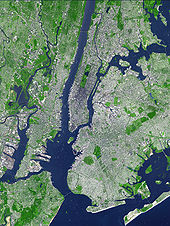Geography
Main articles: Geography of New York City and Geography of New York Harbor
New York City is located in the Northeastern United States, in southeastern New York State, approximately halfway between Washington, D.C. and Boston.[101] The location at the mouth of the Hudson River, which feeds into a naturally sheltered harbor and then into the Atlantic Ocean, has helped the city grow in significance as a trading city. Much of New York is built on the three islands of Manhattan, Staten Island, and Long Island, making land scarce and encouraging a high population density.The Hudson River flows through the Hudson Valley into New York Bay. Between New York City and Troy, New York, the river is an estuary.[102] The Hudson separates the city from New Jersey. The East River—a tidal strait—flows from Long Island Sound and separates the Bronx and Manhattan from Long Island. The Harlem River, another tidal strait between the East and Hudson Rivers, separates most of Manhattan from the Bronx. The Bronx River, which flows through the Bronx and Westchester County, is the only entirely fresh water river in the city.[103]
The city's land has been altered substantially by human intervention, with considerable land reclamation along the waterfronts since Dutch colonial times. Reclamation is most prominent in Lower Manhattan, with developments such as Battery Park City in the 1970s and 1980s.[104] Some of the natural variations in topography have been evened out, especially in Manhattan.[105]
The city's total area is 468.9 square miles (1,214 km2). 164.1 sq mi (425 km2) of this are water and 304.8 sq mi (789 km2) is land.[27][28] The highest point in the city is Todt Hill on Staten Island, which, at 409.8 feet (124.9 m) above sea level, is the highest point on the Eastern Seaboard south of Maine.[106] The summit of the ridge is mostly covered in woodlands as part of the Staten Island Greenbelt.[107]

No comments:
Post a Comment
Thank you for commenting. Eric Kuvykin